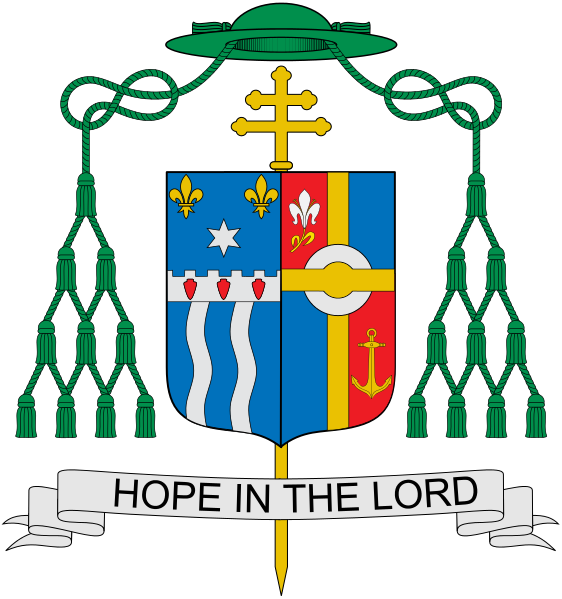
Blazon:
Arms impaled. Dexter: Azure, on a fess embattled Argent, between in chief a mullet of six points of the second, below two fleur-de-lis Or and in base issuant two pallets wavy of the second, three arrowhead, points to base, Gules. Sinister: Quarterly Gules and Azure; throughout a cross Or, interlaced at the center by an annulet Argent; in chief dexter a lily of the last and in base sinister an anchor of the third.
Significance:
The archiepiscopal heraldic achievement or archbishop’s coat of arms is composed of a shield with its charges (symbols), a motto scroll and the external ornamentation. The shield, which is the central and most important feature of any heraldic device, is described (blazoned) in 12th century terms that are archaic to our modern language, and this description is presented as if given by the bearer with the shield being worn on the arm. Thus, where it applies, the terms dexter and sinister are reversed as the device is viewed from the front.
By heraldic tradition the arms of the bishop, who is the “first among equals” of an ecclesiastical province, called a “metropolitan archbishop,” are joined, impaled, with the arms of his jurisdiction. In this case, these are the arms of the Archdiocese of Louisville.
These arms are composed of a blue field to denote the “bluegrass” region of Kentucky in which the See City of the Archdiocese is located. On this field is a silver (white) embattled fess (horizontal bar across the middle) to represent the fortification, now known as Corn Island, which General George Rogers Clark built in 1778 in the midst of the falls, represented by the two wavy silver (white) pallets issuant from the base of the fess, in what is now the city of Louisville. On this fess are three red arrowheads emblematic of the French and Indian War, which raged in and around the area that is now Louisville.
Above the embattled fess are a silver (white) six pointed star below two gold (yellow) fleurs-de-lis. The fleurs-de-lis are used to recall the legislative act of Virginia that incorporated the settlement under the name of Louisville in recognition of the assistance of King Louis XVI of France to the American colonies during the Revolutionary War. They further represent the French missionaries who brought the Gospel to the region, particularly Bishop Flaget, the first Bishop of Bardstown, which had given rise to 28 other dioceses by 1910 and the number has increased since then. The star represents the Blessed Virgin Mary, in her title of the Assumption, titular of the Cathedral Church in the See City.
For his personal arms, His Excellency, Archbishop Kurtz continues to use the design that was adopted upon his selection to receive the fullness of Christ’s priesthood as a bishop, when he was appointed, ordained, and installed as Bishop of Knoxville in 1999.
On a field that is quartered red and blue is a golden (yellow) cross of the faith. Encircling the center of the cross is a silver (white) ring, called an annulet, which is taken from the arms of the Archbishop’s home diocese of Allentown, Pennsylvania. The annulet, sometimes referred to as the “espousal ring,” is used to honor St. Catherine of Siena titular patroness of the cathedral in Allentown.
In the upper left (chief dexter) of the Archbishop’s personal arms is a silver lily for His Excellency’s baptismal patron, Saint Joseph, the foster father of Christ. In the lower right (base sinister) is a gold anchor, the classic symbol of hope. It is used to acknowledge the virtue of hope as a most precious gift of God, by which “we desire the kingdom of heaven and eternal life as our happiness, placing our trust in Christ’s promises and relying not on our own strength but on the help of the grace of the Holy Spirit.” (Catechism of the Catholic Church, No. 1817)
For his motto, Archbishop Kurtz continues to use the phrase, “Hope In The Lord.” By the use of this phrase from Psalm 31:25, the Archbishop expresses his profound belief that all lasting hope finds its source in the person of Jesus Christ. Every human person, “buoyed up by hope,” is preserved from selfishness and led to happiness that flows from charity. (Catechism of the Catholic Church, No. 1818)
The achievement is completed with the external ornaments, which are a gold archiepiscopal processional cross that has two cross-members, that is placed in back of and which extends above and below the shield, and the pontifical hat, called a “gallero,” with its ten tassels, in four rows, on either side of the shield, all in green. These are the heraldic insignia of a prelate of the rank of archbishop, by instruction of the Holy See of March 31, 1969.
by: Deacon Paul J. Sullivan

